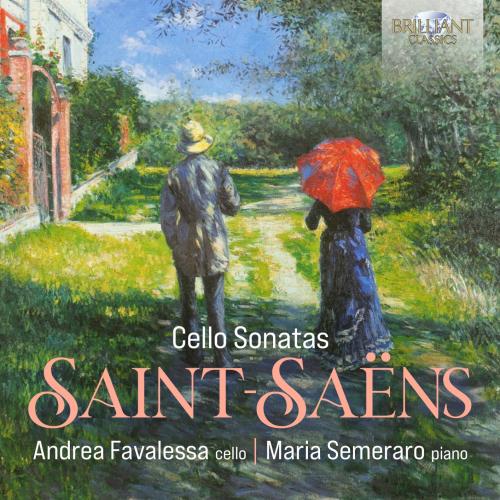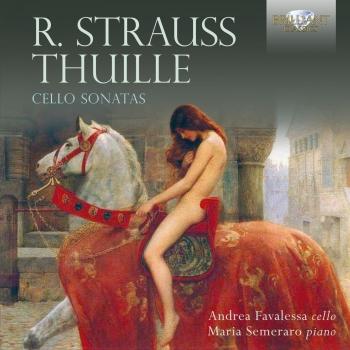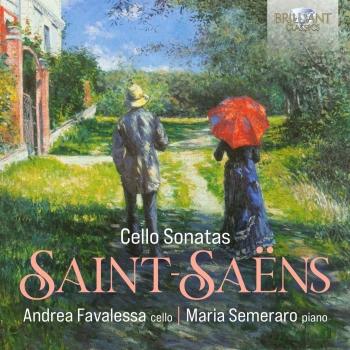
Saint-Saens: Cello Sonatas Andrea Favalessa & Maria Semeraro
Album info
Album-Release:
2022
HRA-Release:
26.08.2022
Label: Brilliant Classics
Genre: Classical
Subgenre: Chamber Music
Artist: Andrea Favalessa & Maria Semeraro
Composer: Camille Saint-Saens (1835-1921)
Album including Album cover
- Camille Saint-Saëns (1835 - 1921): Cello Sonata No. 1 in C Minor, Op. 32:
- 1 Saint-Saëns: Cello Sonata No. 1 in C Minor, Op. 32: I. Allegro 08:55
- 2 Saint-Saëns: Cello Sonata No. 1 in C Minor, Op. 32: II. Andante tranquillo Sostenuto 05:49
- 3 Saint-Saëns: Cello Sonata No. 1 in C Minor, Op. 32: III. Allegro Moderato 06:14
- Cello Sonata No. 2 in in F Major, Op. 123:
- 4 Saint-Saëns: Cello Sonata No. 2 in in F Major, Op. 123: I. Maestosto, Largamente 09:26
- 5 Saint-Saëns: Cello Sonata No. 2 in in F Major, Op. 123: II. Scherzo con variazioni. Allegro Animato 09:12
- 6 Saint-Saëns: Cello Sonata No. 2 in in F Major, Op. 123: III. Romanza. Poco Adagio 08:57
- 7 Saint-Saëns: Cello Sonata No. 2 in in F Major, Op. 123: IV. Allegro non troppo, Grazioso 06:42
Info for Saint-Saens: Cello Sonatas
Prior to the turn of the 20th century, Camille Saint-Saëns enriched the cello repertoire with two important compositions his Cello Concerto No.1 in A minor (Op.33) and his Cello Sonata No.1 in C minor (Op.32), which he dedicated to cellist Jules Lasserre. The writer Emile Baumann hailed this first Cello Sonata as “a unique work”, a masterpiece. It was composed in the autumn of 1872, and its first public performance – with J. Reuschel on cello and the composer at the piano – was given on 26 March 1873 at the Salle Érard in Paris. The work is divided into three movements: the first and third have a tragic character, while the second offers an oasis of quiet serenity. The work opens with a dramatic Allegro in sonata form. The second movement stems from an organ improvisation performed by Saint-Saëns at Saint-Augustin. The final movement takes up the tumultuous and agitated character of the first and ends in an unrelenting race.
Some 30 years separate the Cello Sonata No.2 in F (Op.123) from its predecessor. The fruit of laborious work, it was completed in early 1905. Saint-Saëns, adopting a typically self-deprecating tone – or perhaps merely to manage expectations – wrote to his publisher Jacques Durand on 16 March 1905, ‘Naturally the Second Sonata will not measure up to the First: when La Fontaine published his second collection of fables, everyone declared it inferior to the previous one.’ The Sonata is structured in four movements, the first in sonata form with contrasting heroic and lyrical characters throughout. The second movement is a Scherzo with eight variations, each with its own identity while maintaining a link to the theme, one of them in the form of a fugue. The third movement is, in Saint-Saëns’ words, ‘a romance that will delight cellists’, and he wrote of its concluding section, ‘the Adagio will bring tears to sensitive souls’. The sonata ends with a playful, light Rondo in which both piano and cello engage in technical virtuosity and imitative games.
Camille Saint-Saëns (1835-1921) is one of the most important French composers of the nineteenth century, his oeuvre embracing important orchestral and chamber works, as well as works for solo instruments, alongside a few operas and church music. However, in his time, Saint-Saëns also made his name as a pianist and organist. His music has a universal appeal with its infectious melodies, instrumental brilliance and a happy blend of charm, lyricism and wit.
This new recording presents Saint-Saëns’ two cello sonatas, written 30 years apart from each other, both combining drama and serenity, masterpieces in their genre and cornerstones of the repertoire.
Played by Andrea Favalessa (cello) and Maria Semeraro in wonderful and sensitive partnership, whose earlier recordings for Brilliant Classics (Strauss/Thuille cello sonatas BC 95238 and Casella Complete Works for Cello & Piano BC 94823) received outstanding reviews in the international press.
Recorded December 2020 in Bernareggio, Italy. Bilingual booklet in English and Italian contains liner notes by the pianist, along with a profile of the duo.
Anrea Favalessa plays a Carlo Loveri cello (Naples, 1884).
Andrea Favalessa, cello
Maria Semeraro, piano
Andrea Favalessa
Active as a chamber musician and as a soloist, Andrea Favalessa, he graduated in 2001 with full marks and honors at the "G. Verdi "in Milan under the guidance of Maestro M. Bernardin, and in February 2006 he received the second-level academic diploma in the same Conservatory with honors and praise.
He has participated in various master classes with teachers such as: E. Dindo, M. Brunello, PN Masi, D. Geringas, R. Filippini.
He has won several awards as a soloist in national and international competitions, including first prize at the international competition "Rovere d'Oro" St. Bartholomew, the second prize at the International Competition "S. Omizzolo "of Padua; in November 2011 he was awarded the first prize at the International Cello Competition for Contemporary Music "V. Bucchi "in Rome and in June 2012 he won first prize at the International Competition" G. Zinetti "of Sangli.
In March 2002 he was awarded the bronze medal to the Merit of Culture and Art by the President of the Italian Republic.
He collaborates as a principal cellist with the Orchestra Regionale Toscana, the Orchestra of the Maggio Musicale Fiorentino, the 'Mozart Orchestra of Bologna, the Orchestra of the Teatro Carlo Felice in Genoa.
She collaborates with the Orchestra of the Teatro alla Scala, the Orchestra Filarmonica della Scala, the 'Orchestra Sinfonica Nazionale della RAI and the' Orchestra of Italian Switzerland.
From 2000 to 2003 he was a member of EUYO (European Union Youth Orchestra) and played with important directors in the main European concert halls.
A lifelong passion for chamber music has played with musicians such as Bruno Canino, F. Petracchi, K. Sahatci; Moreover, since 2004 collaborates with the pianist Maria Semeraro with whom he has won several prizes in national and international competitions such as the first prize in the European competition "Duchi D'Acquaviva" of Atri, the first prize and the special prize for the sonata Sandro Fuga in the national competition "S.Fuga" in Turin, the second prize at the international competition "Città di Pinerolo", the first prize at the international competition "Guido Papini" di Camaiore.
In March of 2014 he was released a CD dedicated to their music for cello and piano by Alfredo Casella for the label Brilliant Cassics.
He has performed in various halls and theaters including Venice (Teatro Malibran), Milan (Teatro dal Verme), Buenos Aires (Teatro Coliseu), Imola, Brescia (Auditorium San Barnaba), Bergamo (Piatti Sala), Gradara, Cervo (Piazza Corallini for the chamber music festival), Bologna (Accademia Filarmonica), Trento (Philharmonic Society), Rome (Discoteca di Stato), Padua (Auditorium C. Polini for the Friends of music), Verona (Hall Maffeiana Academy Philharmonic), Ravenna (Teatro Alighieri).
He made his debut as soloist with the Orchestra of the Assumption in Vigentino and later worked as a soloist with the Orchestra of the Musical Afternoons, the 'Philharmonic Orchestra of the Conservatory and the' Chamber Orchestra of Brescia.
In 2002 he recorded with pianist Simone Pioneers Sonata op.38 by Brahms for Stradivarius.
As a member of the ISCM (Italian Society of Contemporary Music) he has performed world premieres and recorded for the record company McHarmony, music for solo cello by E. Morricone, P. Arata, S. Bo, M. Di Gesu.
For the contemporary repertoire he has also collaborated with the Divertimento Ensemble and the 'MDI ensemble.
Andrea Favalessa plays a cello built by Carlo Loveri in 1884.
This album contains no booklet.












